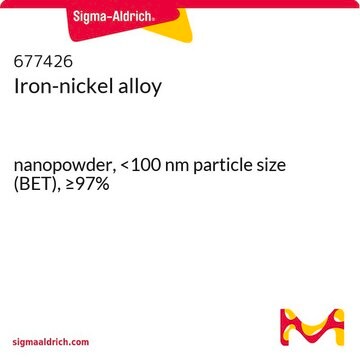推荐产品
化驗
99% trace metals basis
形狀
nanopowder
電阻係數
9.71 μΩ-cm
粒徑
40-60 nm
bp
2750 °C (lit.)
mp
1535 °C (lit.)
密度
7.86 g/mL at 25 °C (lit.)
應用
battery manufacturing
SMILES 字串
[Fe]
InChI
1S/Fe
InChI 密鑰
XEEYBQQBJWHFJM-UHFFFAOYSA-N
應用
訊號詞
Warning
危險聲明
危險分類
Flam. Sol. 2 - Self-heat. 2
儲存類別代碼
4.2 - Pyrophoric and self-heating hazardous materials
水污染物質分類(WGK)
nwg
閃點(°F)
69.8 °F
閃點(°C)
21 °C
其他客户在看
商品
Professor Hui Mao explores the use of superparamagnetic iron oxide nanoparticles (INOPs) that offer an alternate contrast-enhancing mechanism.
Electronically, it behaves as a wide band gap (3.2 eV) semiconductor and exhibits memristor properties.2 Optically, TiO2 has high opacity with a very high refractive index3 (>2.4), and it exhibits strong absorbance in the UV range.
Professor Yadong Yin (University of California Riverside, USA) examines both direct (thermal decomposition, solvothermal, hydrothermal) and indirect (templated) synthesis methods of magnetite nanocrystals and reviews in detail the landscape of these various synthetic methods for magnetite nanocrystal and their applications in magnetic assembly, magnetic hyperthermia, and Li-Ion batteries.
Magnetic materials permeate numerous daily activities in our lives. They are essential components of a diversity of products including hard drives that reliably store information on our computers, decorative magnets that keep the shopping list attached to the refrigerator door, electric bicycles that speed our commute to work, as well as wind turbines for conversion of wind energy to electrical power.
我们的科学家团队拥有各种研究领域经验,包括生命科学、材料科学、化学合成、色谱、分析及许多其他领域.
联系技术服务部门







